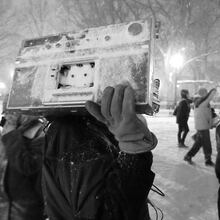When your father tells you he wants to be buried next to his parents, it can pose a problem if the family graveyard has disappeared.
“This cemetery was so overgrown you couldn’t see it from the street,” photographer Doug Yancey said one morning, wielding a chain saw on some fallen trees at the South Bend Cemetery in southeast Atlanta, near the federal penitentiary. “My family had a plot here for 100 years, but we couldn’t find it, we couldn’t drive into it.”
Behind him, Brent Boling drove a lawn mower over the grassy areas between plots while their friend Richard Williamson used a front-end loader to drop tree limbs into a dump truck.
It looks beautiful now, but South Bend Cemetery, with graves dating from the 1800s, had gone back to nature by the time Yancey and a group of 30 or so volunteers started working on it. In the past three years, they have transformed it from jungle into garden.
Mimosa trees grew up through family plots, pushing grave markers to the side. Headstones settled and toppled. Pine seedlings, vines and brush covered the area. Adding insult to injury, construction crews had illegally dumped multiple truckloads of shingles, old tires and other debris in mounds all over the 2.5-acre lot.
Despite this neglect, South Bend was a notable cemetery. It was the same age as Atlanta’s venerable Oakland Cemetery and was the resting place for perhaps 24 soldiers who had served in the Civil War.
A stone for an unknown Confederate soldier, dedicated by the United Daughters of the Confederacy, read, “Confederate soldier, unknown to fame, died for his country all the same. Rest soldier thy warfare.” A bronze marker from the state Historical Commission designated South Bend a historic cemetery.
South Bend’s luck went wrong when the Methodist church down the street that gave the cemetery its name went out of business in 1969. Most of the descendants moved out of the neighborhood in the 1960s. A few years ago thieves stole the historic marker, probably to reclaim the bronze. (This year thieves — perhaps the same ones — stole the metal piping from the restrooms at the nearby South Bend Park swimming pool.)
“People were afraid to come over here,” said Boling, 68, of Conyers, trimming grass near the grave of his grandfather, Herbert Clark.
It doesn’t take long for a cemetery to disappear. “All of them are wooded, and everything drops seeds,” said Larry Upthegrove, 65, of Tucker. “After three or four years the growth could be chest-high.”
Upthegrove helped reclaim the Utoy Church Cemetery in southwest Atlanta, where Atlanta’s first physician, Joshua Gilbert, is buried. He regularly conducts tours at Oakland and said the crowds there indicate a growing interest in past generations.
“In the old days if you had six people [in a tour], you had a crowd; now there’s 30 or 40,” Upthegrove said.
This could be because baby boomers are getting old. “People don’t get interested in genealogy until their 60s,” said Susan Tasse, 63, a retired schoolteacher, who buried an uncle at South Bend in 1981 and came back in 1989 to find the graveyard impassable. The Brookhaven resident discovered a photograph from around 1904 of her grandfather with a gathering of South Bend congregants, and it piqued her interest in the site. She began removing debris and clearing brush back in the 1990s.
South Bend’s fortunes turned around in 2008 when the Atlanta Youth Academy bought the land surrounding the cemetery, fenced it in and tried to find the cemetery owners. Failing that, the school organized volunteer days to cut brush and remove illegally dumped tires, clearing 500 tires in one day.
“I think having a cemetery next door is an asset,” said the academy’s executive director, Chuck Johnston. Kids at the academy can learn both math and history from the headstones.
(They might not learn spelling, however: One primitive stone, using a backward “s,” reads “in Memory Caroline Crockett, Who was bornd July 26, 1833.”)
Before Yancey could fulfill his father’s request, he had to complete one more difficult task. The spot next to his grandparents, Newton and Annie L. Yancey, was occupied by Newton’s nephew, Marshall Yancey, who died young in 1950. Doug Yancey had to contact Marshall’s widow and son and ask permission to move his casket 10 feet to the east. They consented. Yancey carefully probed the ground, found Marshall’s concrete vault still intact, excavated a new lot contiguous with the old, and using wooden skids and a winch, moved the vault, very slowly. “It took three weeks.”
Randolph Ogden Yancey of Stone Mountain died one day shy of his 90th birthday on Jan. 24, 2010, and was buried next to his parents.
“You know, the people who do this have a passion for it,” Doug Yancey said. “What would impel me to do this? To spend so much time and money on this? It’s because I believe they are there, somewhere,” he said, indicating his ancestors, resting all around him. “And we need to do this work for them. Not just for their memory, but for them. You think, ‘I’m going to see these people some day so I’d better be nice to them now.’ ”
South Bend Cemetery is next to the Atlanta Youth Academy, which is at 2120 Forest Park Road, Atlanta 30315. Among the 100 or so graves in the cemetery one will find the names Clark, Duncan, Ford, Grogan, Harper, Hubbard, Hughes, Johnston, Jordan, Lawrence, Schell, Shepherd, and Yancey. Those seeking more information should call Doug Yancey at 404-310-5992 or send an email to dougyancey@bellsouth.net.
About the Author




